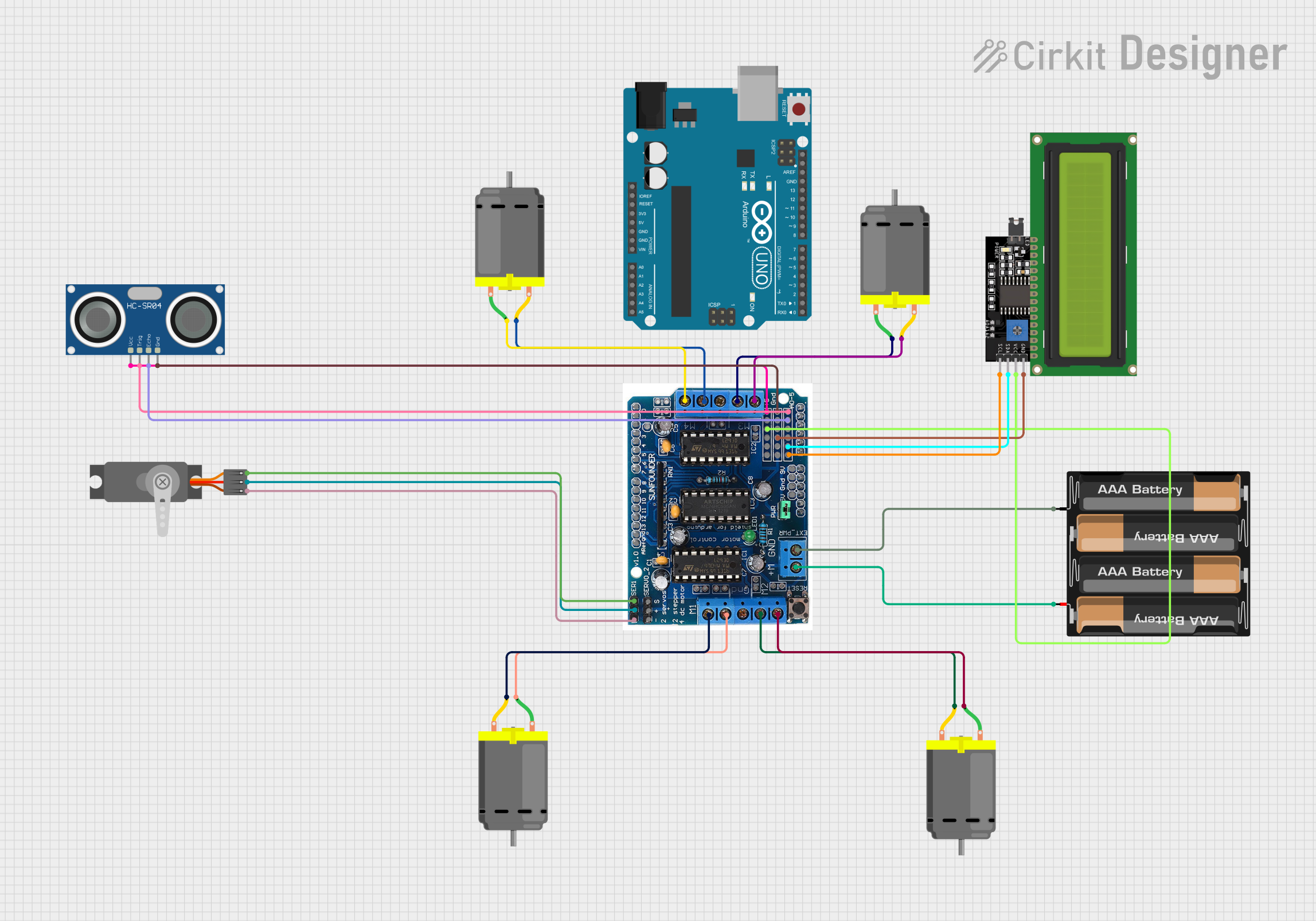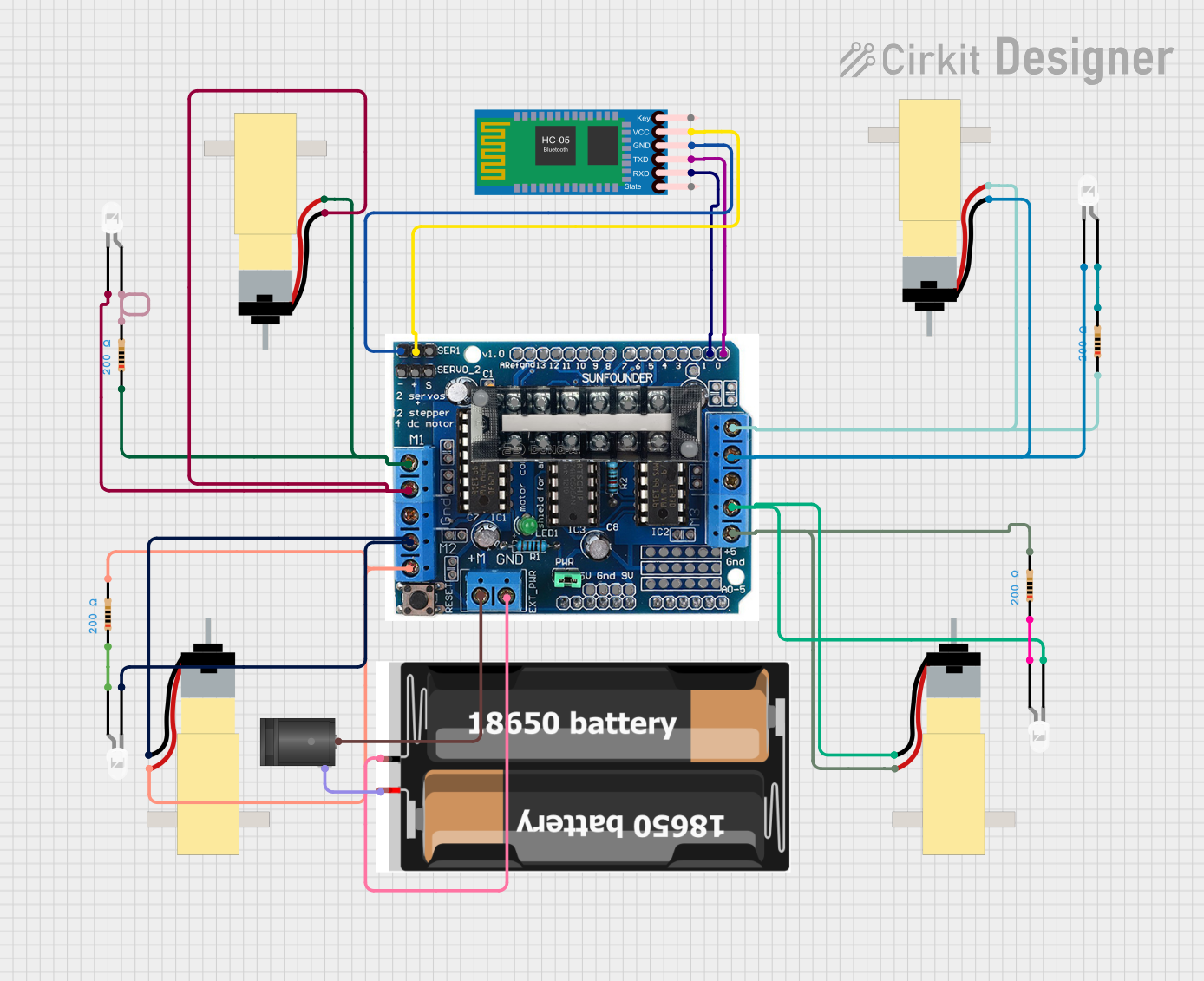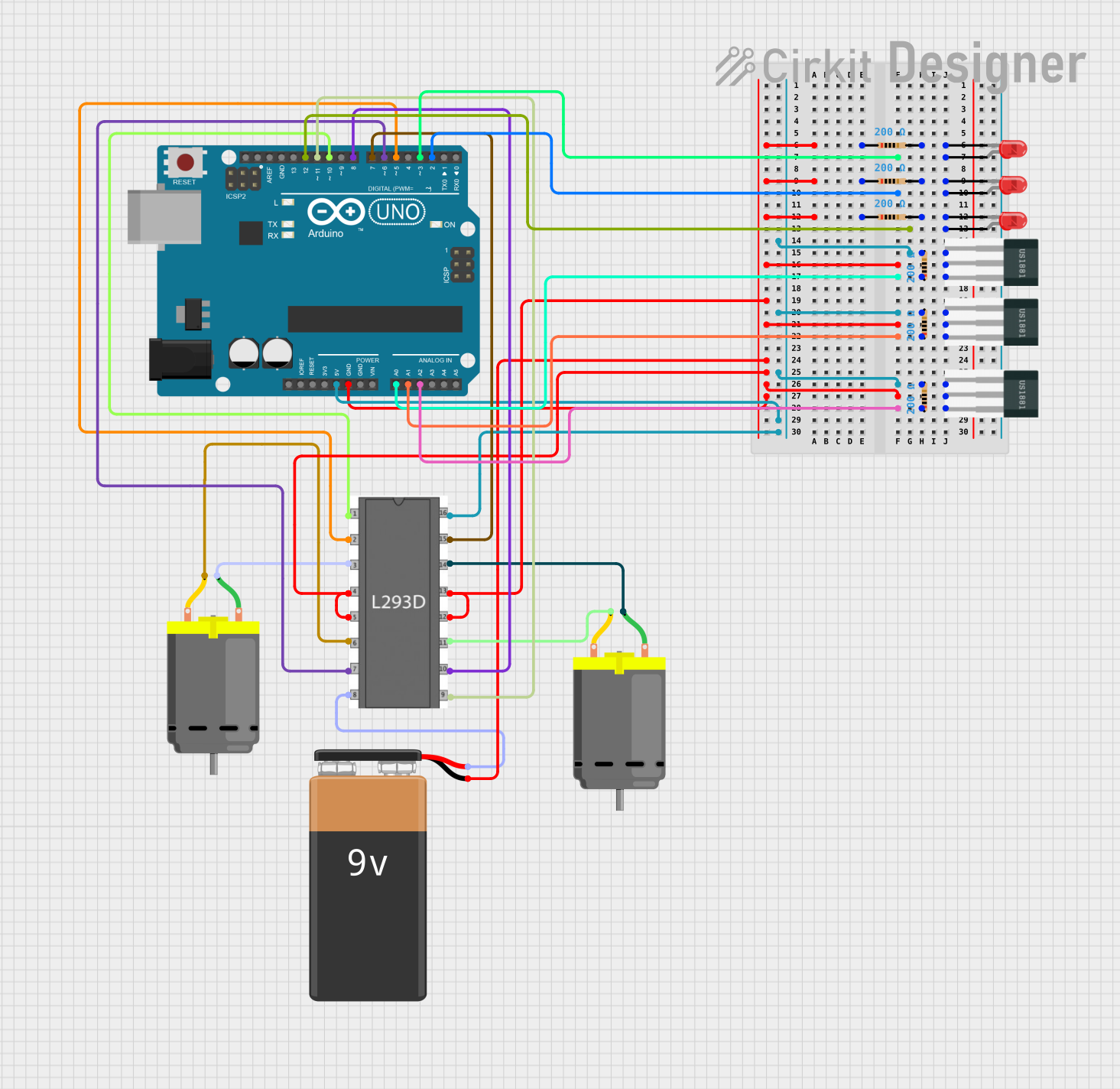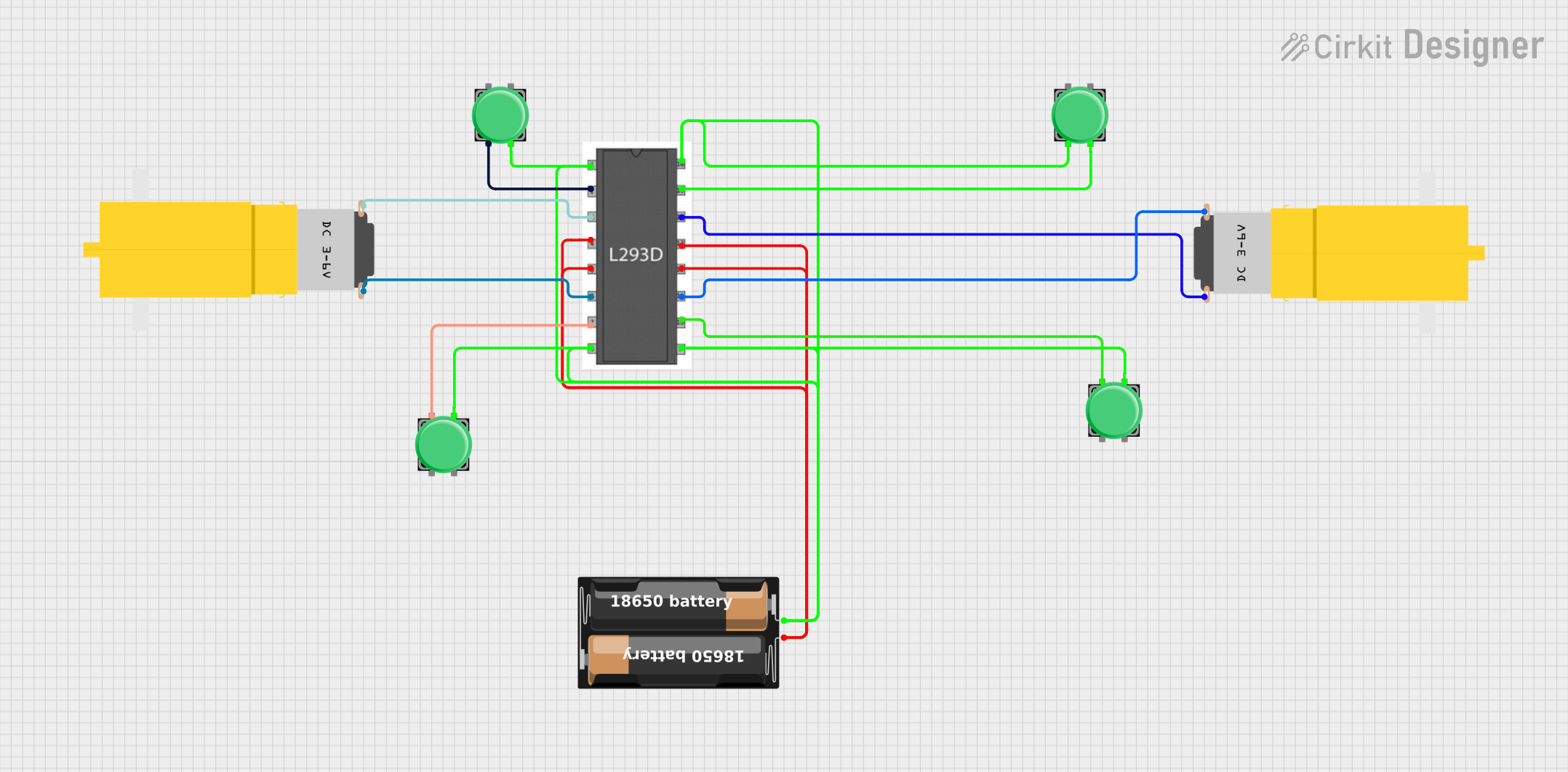
How to Use L293D: Examples, Pinouts, and Specs

 Design with L293D in Cirkit Designer
Design with L293D in Cirkit DesignerIntroduction
The L293D is a dual H-bridge motor driver IC designed to control the direction and speed of DC motors and stepper motors. It is widely used in robotics and automation projects due to its ability to drive two motors simultaneously. Each channel of the L293D can handle up to 600 mA of current, making it suitable for small to medium-sized motors. The IC also features built-in diodes for back-EMF protection, ensuring safe operation with inductive loads like motors.
Explore Projects Built with L293D

 Open Project in Cirkit Designer
Open Project in Cirkit Designer
 Open Project in Cirkit Designer
Open Project in Cirkit Designer
 Open Project in Cirkit Designer
Open Project in Cirkit Designer
 Open Project in Cirkit Designer
Open Project in Cirkit DesignerExplore Projects Built with L293D

 Open Project in Cirkit Designer
Open Project in Cirkit Designer
 Open Project in Cirkit Designer
Open Project in Cirkit Designer
 Open Project in Cirkit Designer
Open Project in Cirkit Designer
 Open Project in Cirkit Designer
Open Project in Cirkit DesignerCommon Applications
- Robotics: Driving wheels or robotic arms
- Automation: Conveyor belts, automated gates
- DIY projects: Remote-controlled cars, drones
- Stepper motor control for CNC machines or 3D printers
Technical Specifications
Below are the key technical details of the L293D motor driver IC:
| Parameter | Value |
|---|---|
| Operating Voltage | 4.5V to 36V |
| Output Current (per channel) | 600 mA (peak: 1.2A) |
| Logic Input Voltage | 0V to 7V |
| Control Logic Levels | Low: 0V, High: 5V |
| Number of Channels | 2 (dual H-bridge) |
| Maximum Power Dissipation | 5W |
| Built-in Protection | Back-EMF diodes |
| Operating Temperature | -40°C to +150°C |
Pin Configuration and Descriptions
The L293D comes in a 16-pin DIP (Dual Inline Package). Below is the pinout and description:
| Pin Number | Pin Name | Description |
|---|---|---|
| 1 | Enable 1,2 | Enables H-bridge 1 (High = Enabled, Low = Disabled) |
| 2 | Input 1 | Logic input for H-bridge 1 (controls motor direction) |
| 3 | Output 1 | Output for H-bridge 1 (connect to motor terminal) |
| 4 | GND | Ground (common ground for logic and motor power) |
| 5 | GND | Ground (common ground for logic and motor power) |
| 6 | Output 2 | Output for H-bridge 1 (connect to motor terminal) |
| 7 | Input 2 | Logic input for H-bridge 1 (controls motor direction) |
| 8 | Vcc2 (Motor V+) | Motor power supply (4.5V to 36V) |
| 9 | Enable 3,4 | Enables H-bridge 2 (High = Enabled, Low = Disabled) |
| 10 | Input 3 | Logic input for H-bridge 2 (controls motor direction) |
| 11 | Output 3 | Output for H-bridge 2 (connect to motor terminal) |
| 12 | GND | Ground (common ground for logic and motor power) |
| 13 | GND | Ground (common ground for logic and motor power) |
| 14 | Output 4 | Output for H-bridge 2 (connect to motor terminal) |
| 15 | Input 4 | Logic input for H-bridge 2 (controls motor direction) |
| 16 | Vcc1 (Logic V+) | Logic power supply (5V) |
Usage Instructions
How to Use the L293D in a Circuit
Power Connections:
- Connect
Vcc1(Pin 16) to a 5V logic power supply. - Connect
Vcc2(Pin 8) to the motor power supply (4.5V to 36V, depending on the motor). - Connect all
GNDpins (Pins 4, 5, 12, 13) to the ground of the power supply.
- Connect
Motor Connections:
- Connect the motor terminals to the output pins (
Output 1andOutput 2for Motor 1,Output 3andOutput 4for Motor 2).
- Connect the motor terminals to the output pins (
Control Logic:
- Use the input pins (
Input 1,Input 2,Input 3,Input 4) to control the direction of the motors. - Enable the H-bridges by setting the
Enablepins (Enable 1,2andEnable 3,4) to HIGH.
- Use the input pins (
Direction Control:
- Set the input pins as follows to control motor direction:
- Input 1 = HIGH, Input 2 = LOW → Motor 1 rotates forward.
- Input 1 = LOW, Input 2 = HIGH → Motor 1 rotates backward.
- Input 3 = HIGH, Input 4 = LOW → Motor 2 rotates forward.
- Input 3 = LOW, Input 4 = HIGH → Motor 2 rotates backward.
- Set the input pins as follows to control motor direction:
Speed Control:
- Use a PWM (Pulse Width Modulation) signal on the
Enablepins to control motor speed.
- Use a PWM (Pulse Width Modulation) signal on the
Example: Connecting L293D to Arduino UNO
Below is an example Arduino code to control a DC motor using the L293D:
// Define motor control pins
const int enablePin = 9; // PWM pin for speed control
const int input1Pin = 7; // Direction control pin 1
const int input2Pin = 8; // Direction control pin 2
void setup() {
// Set motor control pins as outputs
pinMode(enablePin, OUTPUT);
pinMode(input1Pin, OUTPUT);
pinMode(input2Pin, OUTPUT);
}
void loop() {
// Rotate motor forward at 50% speed
analogWrite(enablePin, 128); // Set speed (0-255)
digitalWrite(input1Pin, HIGH); // Set direction
digitalWrite(input2Pin, LOW);
delay(2000); // Run for 2 seconds
// Rotate motor backward at full speed
analogWrite(enablePin, 255); // Set speed (0-255)
digitalWrite(input1Pin, LOW); // Set direction
digitalWrite(input2Pin, HIGH);
delay(2000); // Run for 2 seconds
// Stop the motor
analogWrite(enablePin, 0); // Set speed to 0
delay(2000); // Wait for 2 seconds
}
Important Considerations
- Ensure the motor power supply voltage matches the motor's specifications.
- Do not exceed the maximum current rating of 600 mA per channel.
- Use a heat sink if the IC gets too hot during operation.
- Always connect all ground pins to a common ground.
Troubleshooting and FAQs
Common Issues
Motor Not Spinning:
- Check if the
Enablepin is set to HIGH. - Verify the motor power supply voltage and connections.
- Ensure the input pins are configured correctly for the desired direction.
- Check if the
Motor Spins in the Wrong Direction:
- Swap the logic levels of the input pins (e.g., HIGH to LOW and vice versa).
IC Overheating:
- Ensure the current drawn by the motor does not exceed 600 mA per channel.
- Use a heat sink or reduce the motor load.
No Response from the Motor:
- Check the ground connections between the L293D, power supply, and microcontroller.
- Verify that the logic power supply (
Vcc1) is 5V.
FAQs
Q: Can the L293D drive stepper motors?
A: Yes, the L293D can drive stepper motors by controlling the sequence of inputs to the H-bridges.
Q: Can I use the L293D with a 3.3V microcontroller?
A: The L293D requires a minimum logic voltage of 4.5V. Use a level shifter or a 5V microcontroller for compatibility.
Q: How do I control motor speed with the L293D?
A: Use a PWM signal on the Enable pins to adjust the motor speed.
Q: What happens if I exceed the current rating?
A: Exceeding the current rating can damage the IC. Use motors within the specified current limits or add external current-limiting circuitry.